Pukekohe Hiab Transport lifts the lid on its new Scania R620 B10x4*6. A multi-purpose truck that can do two applications in one, being a rigid truck and also a tractor unit pulling a semi-trailer.
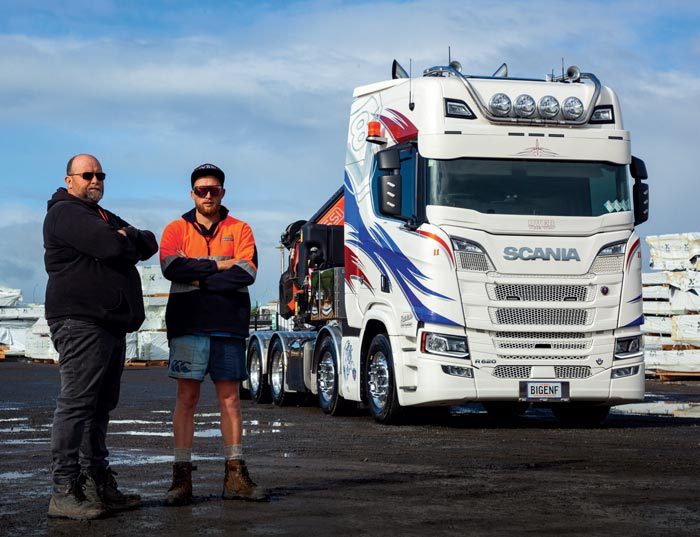
Photo: Pukekohe Hiab Transport owner Craig Morris (left) and BIGENF driver Jordan Morris.
New Zealand has long been known for taking a product and changing it to suit the needs of Kiwi operators. This was very prevalent in the heavy trucking industry, however as New Zealand has moved into a more governed industry, the ‘ole number 8 wire‘ thinking has had to improve dramatically to fit within the safe working conditions we now operate in. With this in mind, when Scania New Zealand was approached by Craig Morris of Pukekohe Hiab Transport to build a unit that didn‘t quite fit into the NZTA‘s guidelines, the thinking cap had to be put on and some hard work done. Of course changing the NZ Transport Agency‘s mind on what configuration of truck axles are permitted on New Zealand roads is not an easy task, and not one you want to take on every day. But when a job needs to be done, and an axle configuration needs to be devised to do that job, it takes a combined effort by the operator, local engineers, and the OEM to make it happen. The finished product is Pukekohe Hiab Transport‘s new Scania R620 B10x4*6. The first truck on New Zealand roads to legally have five axles, a rear steering axle, and be able to pull a semitrailer. But let‘s go back to the start. The rules are quite clear: NZTA‘s factsheet 13A states that ‘Heavy rigid vehicles with a coupling for towing a heavy trailer must not have a rear steering axle‘. That‘s fine, but when you need to be a tractor unit towing a tri-axle semi, or maybe with the addition of a short deck and a 4-axle dog trailer, then add in a rather large mid-mounted Fassi 710 knuckle boom crane, the combinations become quite complicated – especially when you need three rear axles to legally meet the anticipated weights on the rear, and a rear steered tag axle to improve the turning radius.
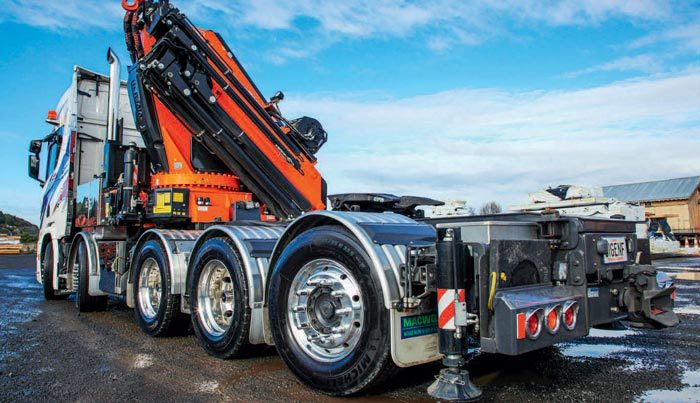
Photo: Crane, fifth wheel, Ringfeder and a rear steering axle. Not an easy one to accomplish.
This job fell into the lap of Eddie Davids, Scania New Zealand‘s in-house sales engineer. To comply with New Zealand rules he initially approached the Scania factory with a request to permanently lock the rear steered axle. This was duly refused due to no development by Scania of a 5-axle truck without rear steer. The only option from Scania was a 5-axle truck with rear steered tag that complied with European ECE standards. Scania did not see any benefit in a proposed business case to research such a configuration with a fixed tag axle when the steered versions work well. Eddie then turned to the NZTA to see how such a configuration could possibly be achieved within New Zealand‘s framework and there were two areas to be examined: the rule regarding steering axles, and the other aspect of the law to be considered was getting the rear axle bogie rated to 18 tonne. The Scania trailing axle is fitted with super single tyres and they would need to be recognised as twin tyres to fall within New Zealand‘s triaxle set criteria. As you can imagine there was much toing and froing, which eventuated in an exemption to the rule, and the rest, as they say, is history. But in this case it‘s not, as the truck is very much a case study and will be watched to ensure it carries on performing as expected.
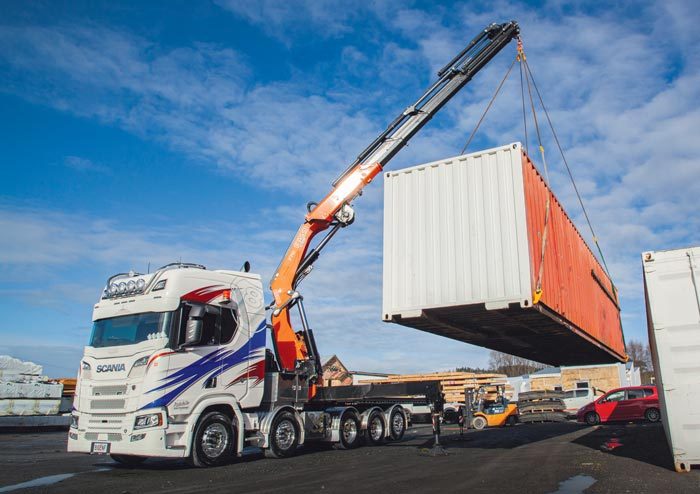
Photo: Easy does it…
Pukekohe Hiab
Craig Morris and his wife, Janine, started their family trucking business Pukekohe Hiab 15 years ago. Trucking for Craig is in the blood. His father owned trucking firm B & M M Morris Limited and was an ownerdriver for Colgate Palmolive. Craig‘s father put him behind the wheel at 18 in a 3-tonne Ford Trader. After doing his time in the Ford, he worked his way up the fleet into a D1314 before getting into the big time with a new N-series Ford. B & M M Morris was carting containers from the railhead to be devanned and then delivered to various bulk warehouses around the Auckland region. The company then went on to deliver these goods to most of the food shops around Auckland. Craig become an ownerdriver for them in 1994 at Bluebird Foods until the end of the contract in 1999. After this he went back driving for other companies but decided that being self-employed was where he was heading and he has been at it ever since. He and Janine bought a secondhand Mitsi and new Palfinger crane and have carried on building the business. Pukekohe Hiab, based south of Auckland, has had a mixed fleet over the years. The first two Hiab trucks were actually Mitsubishi; they then quickly moved to European, and the first tractor/Hiab combination unit they had built was a Scania 124 GB.
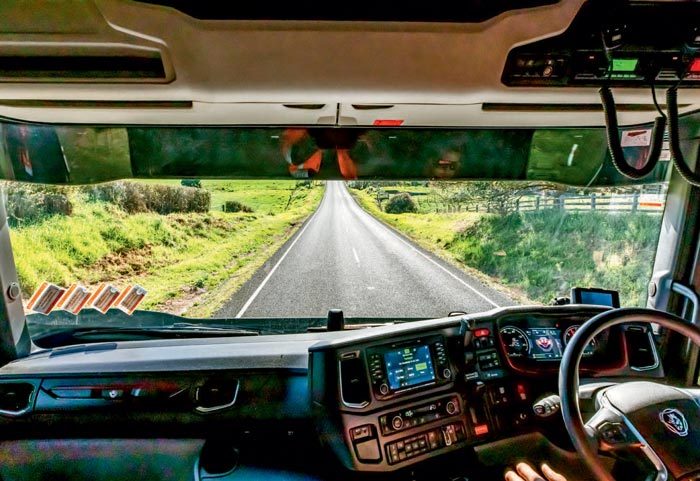
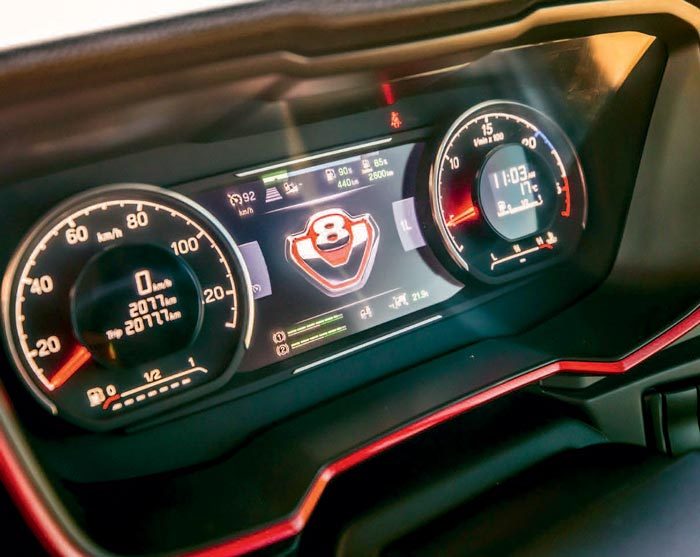
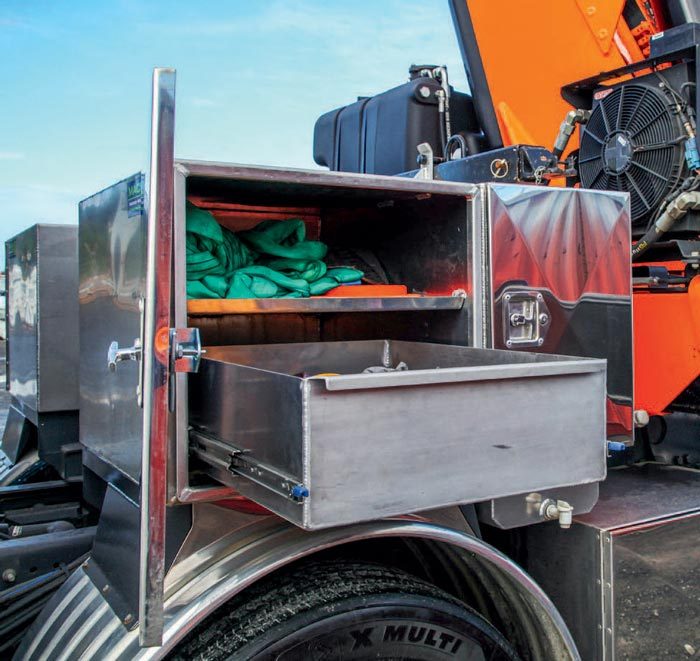
Craig mentions that he chose Scania because of the wider spacing in the front steer group helping with the weight of the crane. The company now has four Scania crane trucks, two rear-mounted and two tractor units (including the new one). The company also has three Scania tractor units with reefer trailers contracted to Foodstuffs NI. The fleet also has a Fuso, a DAF, and a Hino. Up until this new unit, Craig has built his Scania crane trucks on secondhand chassis and the latest unit may have been also, but after an exhaustive search the right chassis couldn‘t be found and the new build was commissioned. Craig tends to work with McKenzie Welding in Kaitaia, which is a little way north. In his experience, having Don, Thomas, and the team from McKenzies build them means that all the little extras they add make the truck operation easier, and the finishing, including the stainless dressing of the toolboxes and other little bits and pieces, make the drivers proud of the gear.
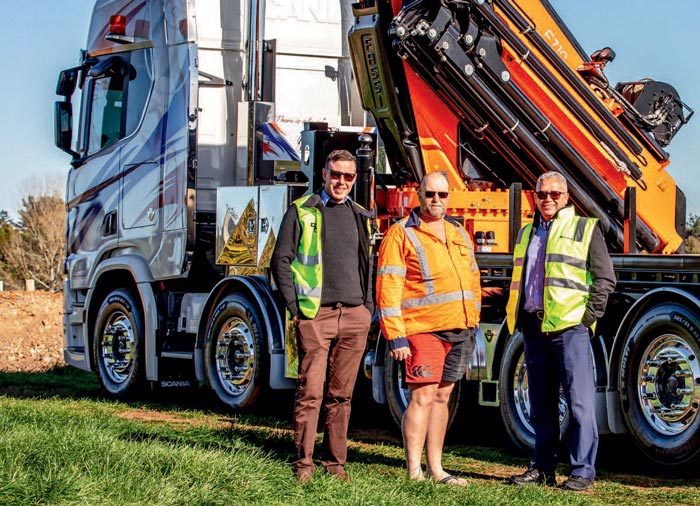
Photo: Craig takes delivery from Scania New Zealand account manager Blair Stapleton (left) and product engineer Eddie Davids.
Introducing BIGENF
The new Scania is a R620 B10x4*6 (R – rest cab, 620 – horsepower, B – chassis adaptation, 10×4*6 – wheel configuration, the *6 means the vehicle is equipped with a non-driving tag axle behind the rearmost driving axle). Blair Stapleton, the Scania account manager who put the truck build together, is very happy with the finished product. “To work with someone who knew what they wanted and could visualise the finished product made the build go so easy,” he says. Being an NTG (Scania‘s acronym for the New Truck Generation), it‘s the latest offering from the Scania brand and features many of the safety and bodywork features available. The reconfigured cab is perfect for the crane industry, with the driving position allowing good visibility as the operator moves around cramped and busy worksites. The Euro 5 engine is a DC16 115 with 462kW and 3000Nm of torque (620hp and 2212.6ft/lb for you old fellas), and it‘s coupled to a manual gearbox, which is rare these days, but the cab fitout is just what you‘d expect from Scania: leather everywhere, the V8 interior package with red trim, V8 leather steering wheel, and a fridge.
The truck arrived with the necessary functions to ensure the crane works with the truck and that the axle configuration complies with the NZTA exemption. The steered tag axle is equipped with Scania‘s electrohydraulic tag axle steering system (EST). With EST, an electronic control unit receives information about the steering wheel angle and vehicle speed and sends signals to an electrohydraulic pump unit that is located close to the tag axle in the rear. This unit generates the required pressure to manoeuvre the hydraulic cylinder of the tag axle, adapted to the driving situation (in this case under 40kph only). A quick look at the livery of the truck says that Craig has put quite some effort into making this his pride and joy. The graphics are impressive and set off what is an impressive unit for both Pukekohe Hiab Transport and Scania New Zealand, and of course a first for the New Zealand trucking industry.
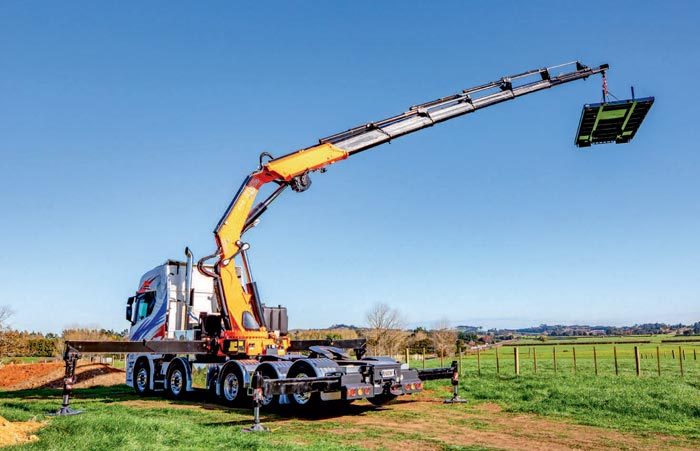
Photo: Fassi F1710RA.22.8 – max lift capacity of 12.7 tonne at 4.5m reach, and 1.3 tonne at the maximum 25m extension.
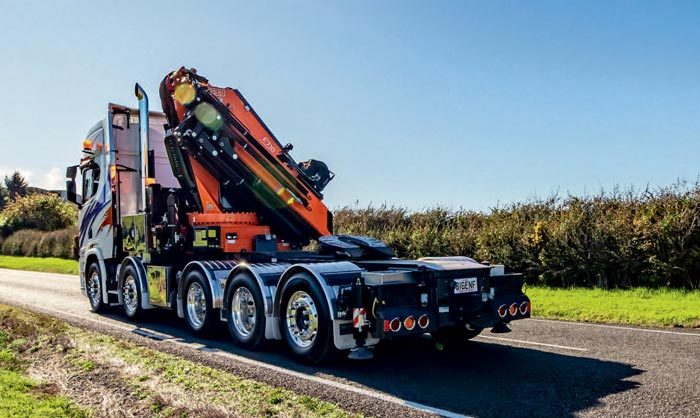
Photo: BIGENF has a helluva presence on the road.




